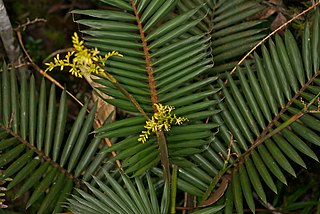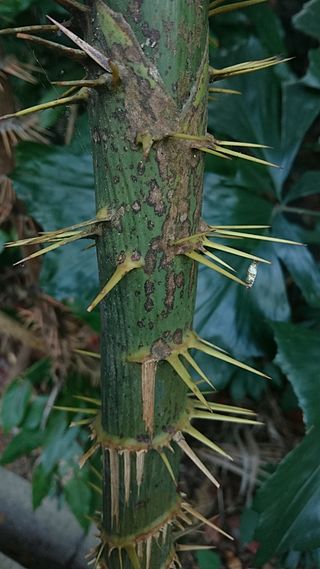
Calamus is a genus of flowering plants in the palm family Arecaceae that is one of several genera known as rattan palms. There are an estimated 400 species in this genus, all native to tropical and subtropical Asia, Africa, and Australia.

Livistona is a genus of palms, the botanical family Arecaceae, native to southeastern and eastern Asia, Australasia, and the Horn of Africa. They are fan palms, the leaves with an armed petiole terminating in a rounded, costapalmate fan of numerous leaflets.

Daemonorops was a genus of rattan palms in the family Arecaceae. Its species are now included within the genus Calamus. Species now placed in Daemonorops are dioecious, with male and female flowers on separate individuals. They are found primarily in the tropics and subtropics of southeastern Asia with a few species extending into southern China and the Himalayas.

Licuala is a genus of palms, in the tribe Trachycarpeae, commonly found in tropical forests of southern China, Southeast Asia, the Himalayas, New Guinea and the western Pacific Ocean islands.

Borassodendron is a genus of flowering plant in the family Arecaceae. It contains two species, native to Southeast Asia.

Orania is a genus of the palm tree family Arecaceae, whose native is Madagascar, Malesia, and New Guinea.

Korthalsia is a clustering genus of flowering plant in the palm family spread throughout Southeast Asia. It is a highly specialized rattan with some species known to have an intimate relationship with ants, hence the common name ant rattan. High-climbing and armed with spines, the genus is named for the Dutch botanist P. W. Korthals who first collected them from Indonesia.

Myrialepis is a monotypic genus of flowering plant in the palm family. The single species, Myrialepis paradoxa, is native to Southeast Asia. The genus name is a combination of the Greek words meaning "innumerable" and "scale", a description of the fruit, and the epithet is Latin for "paradox".

Ceratolobus was a dioecious genus of flowering plants in the palm family found in Southeast Asia, commonly called rotan. Its species are now included within the genus Calamus. They were only differentiated from Calamus and close relatives like Korthalsia by leaf sheath appendages or inflorescence variations. The Greek genus name combines "horn" and "capsule".
Dypsis brevicaulis is a species of flowering plant in the Arecaceae family. It is a dwarf palm found on only three sites in Madagascar, with fewer than fifty plants ever found in the wild. The plant is part of the IUCN Sampled Red List Index for Plants, a study of representative species from all over the world which is studying extinction trends for plants.

Oncosperma tigillarium is an Asian species of palm tree in the family Arecaceae.
Plectocomia pierreana is a species of liana in the Arecaceae, or palm tree, family. It is a spiny climber, with either a single stem or a cluster of stems up to 35 m in length, stems are 1 to 9 cm in diameter. Its spines are up to 2 cm long.
Pinanga sylvestris is a species of tree in the Arecaceae, or palm tree, family. It grows 2-6 m tall, sometimes in bundles, shade tolerant, from Meghalaya (India) to Thailand, Cambodia, Vietnam, Laos and Zhōngguó/China. In Thailand it is recorded in the Khao Soi Dao Wildlife Sanctuary, in Chanthaburi Province, as a very common mid-storey tree in the Quercus semiserrata-dominated rainforest at 1,400 to 1,540 m. In Cambodia it occurs uncommonly in coastal vegetation communities, but is common in dense and semi-dense evergreen rainforest in the lowlands and at moderate altitude. The palm grows in similar dense and semi-dense communities in Laos and Vietnam. On the mountain of Ngọc Linh in Quảng Nam Province of Vietnam, it dominates the ground layer of low montane broadleaf evergreen forest, that occurs from 150 to 1000m.
A liana in the Arecaceae, or palm, family, Korthalsia bejaudii is an endemic growing in the forests of Cambodia, noted from Kampong Cham Province. The species is distinguished by shortened, truncate ocrea that do not disintegrate and possessing flattened spines, crowded near the tip, and leaves that are the same colour either side.
A large, very high liana, or "climbing tree" in the palm family, Korthalsia laciniosa occurs in the closed forests of Java, Sumatra, the Philippines, Malay Peninsula, Vietnam, Cambodia and elsewhere in Indochina, and the Nicobar and Andaman Islands.
Calamus viminalis, one of many Calamus species commonly referred to as rattan, is a plant of the Arecaceae, or palm, family native to: Java and Bali in Indonesia; Peninsular Malaysia; all parts of Thailand; Cambodia; Cochinchina and Central Annam in Vietnam; all parts of Laos; Myanmar; Bangladesh; Andaman and Nicobar Islands; North-east, North-central, and South India; and probably north-west and south Yunnan in China.
Calamus tetradactylus is a climbing plant in the Arecaceae, or palm, family, and is part of a subfamily, Calamoideae, whose members are usually called rattans in English. It is native to southeast and east Thailand, Cambodia, Vietnam, south and central Laos, and Yunnan and elsewhere in southeast China. It grows in evergreen forest and scrub between 100 and 1,000m elevation. In Cambodia, it is described as a large and long rattan, its stalk growing from 20 to 70m long, growing in secondary formations near rivers.
Native to south Vietnam and Cambodia, Calamus salicifolius, is commonly referred to as a rattan, it is one of many Calamus species of the Arecaceae, or palm, family. It is described as a little bushy plant, often climbing, even on itself, with a 2 to 4m long stalk. It is found in deforested/severely degraded lowland areas and near houses, growing well in grasslands, scrub, roadside verges, ricefield bunds and peri-urban wastelands. Typically it occurs in floodplains with seasonal shallow flooding.
Calamus latifolius is a climbing plant, part of a subfamily, Calamoideae, whose members are usually called rattans in English, they are part of the Arecaceae, or palm, family.
Part of a group, the subfamily Calamoideae, whose members are usually called rattans in English, Calamus godefroyi, is a climbing plant, and part of the Arecaceae, or palm, family.









